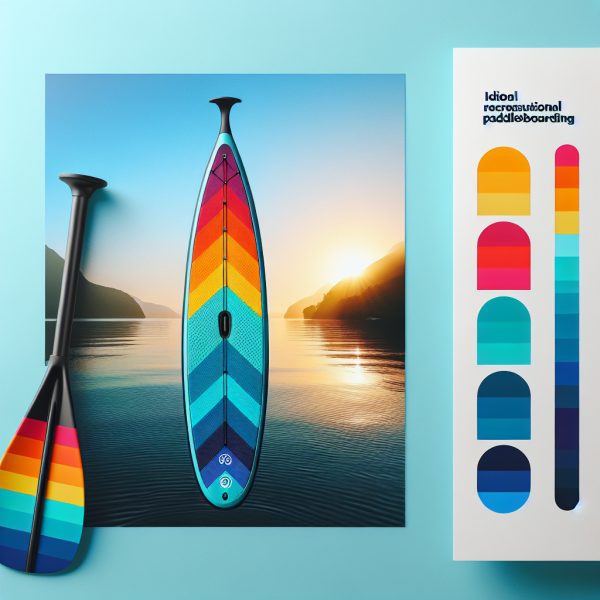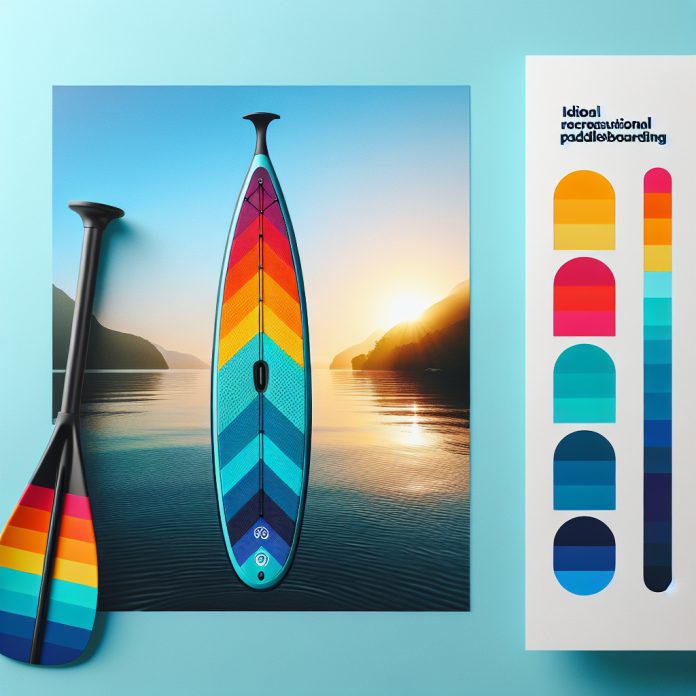Join us as we explore the world of stand-up paddleboarding (SUP) and delve into the essential question: what is the ideal SUP paddle length for recreational paddling? Whether you’re a beginner or a seasoned paddler, finding the right paddle length can greatly enhance your paddling experience and ensure optimal performance. In this article, we’ll guide you through the factors to consider when choosing a paddle length, such as your height, paddling style, and board size. Get ready to dive into the wonderful world of SUP paddling and discover the perfect paddle length for your recreational adventures.

Factors to consider
When choosing the ideal SUP paddle length, there are several important factors to consider. These factors include the height of the paddler, the type of paddling, the width of the SUP board, the paddle stroke style, the experience and fitness level of the paddler, and personal preference. By taking all these factors into account, we can determine the perfect paddle length for every individual.
Measuring the ideal SUP paddle length
To measure the ideal SUP paddle length, you need to consider whether you are using a stand-up paddle or an inflatable paddleboard. The measurement process may vary slightly depending on the type of board you have.
When using a stand-up paddleboard, the common method is to ensure that the paddle reaches your wrist when standing on the board. This measurement allows for comfortable and efficient paddling, as it ensures the proper reach and extension of your arms. It’s important to note that this measurement is taken when the board is on the water and you are standing on it.
In the case of an inflatable paddleboard, the measurement process is slightly different. It’s recommended to adjust your paddle length by adding a few inches to accommodate for the added height of the board when fully inflated. This adjustment ensures that your paddle is the correct length when paddling on an inflated board.
Additionally, it’s essential to consider the different conditions you may encounter while paddleboarding. Choppier waters or stronger currents may require a slightly shorter paddle length for better control and stability, while calmer waters may allow for a longer paddle length to maximize efficiency and speed.
Effects of using the wrong paddle length
Using the wrong paddle length can have a significant impact on your paddleboarding experience. It can lead to various issues such as fatigue and muscle strain, inefficient paddling technique, difficulty in controlling the board, and reduced speed and maneuverability.
One of the most common issues caused by using the wrong paddle length is fatigue and muscle strain. If your paddle is too long, it requires excessive effort from your arms and shoulders, resulting in fatigue and potential discomfort. Conversely, if your paddle is too short, you may find yourself hunching over, causing strain in your back and shoulders.
In addition to physical strain, using the wrong paddle length can lead to an inefficient paddling technique. A paddle that is too long or too short can disrupt the proper form and rhythm of your strokes, reducing the effectiveness of each paddle stroke.
Difficulty in controlling the board is another consequence of using the wrong paddle length. If your paddle is not the correct length, it can be challenging to maintain stability and balance on the board, especially in rougher conditions.
Furthermore, using an incorrect paddle length can result in reduced speed and maneuverability. A paddle that is too long may limit your ability to quickly change direction or navigate tight turns, while a paddle that is too short may hinder your overall speed and efficiency.
Choosing the right paddle length
Choosing the right paddle length is crucial for optimal performance and enjoyment on the water. Depending on whether you are using a stand-up paddle or an inflatable paddle, there are different considerations to take into account.
For stand-up paddles, the general guideline is to choose a length that allows the paddle to reach your wrist when you are standing on the board. This length ensures comfort, proper reach, and extension of your arms during paddling.
When it comes to inflatable paddles, it’s important to make adjustments for the added height of the board when fully inflated. By adding a few inches to your paddle length, you can ensure that it remains the correct length when paddling on an inflated board.
Considering the height of the paddler
The height of the paddler is an important factor to consider when determining the ideal SUP paddle length. A longer paddle is generally recommended for taller individuals, while a shorter paddle is usually more suitable for those of shorter stature.
For individuals who are taller, a longer paddle length allows for a greater reach and extension when paddling. This increased reach maximizes the power and efficiency of each stroke, contributing to a smoother and more effective paddling experience.
On the other hand, shorter individuals may find a shorter paddle more comfortable and manageable. A shorter paddle allows for easier control and maneuverability, which can be beneficial, especially for beginners or those looking for a more casual paddling experience.
It’s important to note that individual preferences and paddling styles can also influence paddle length selection, even for individuals of the same height. Some may prefer a slightly longer paddle for increased speed, while others may opt for a shorter paddle for enhanced maneuverability.
Considering the type of paddling
The type of paddling you plan to engage in also plays a crucial role in determining the ideal SUP paddle length. Different paddle lengths may be more suitable depending on whether you are engaged in recreational paddling, touring paddling, or racing.
For recreational paddling, a paddle length that allows for comfortable, leisurely paddling is generally preferred. This paddle length should provide adequate reach and control for relaxed paddling sessions, allowing you to enjoy the scenery and take your time on the water.
In contrast, touring paddling often requires longer paddle lengths. These longer paddles are designed to facilitate efficient and sustained paddling over extended distances. The added length allows for increased power and speed, enabling you to cover more ground during each stroke.
For racing, the ideal SUP paddle length depends on the specific requirements and regulations of the race. Competitive racing often involves shorter, more rigid paddles that prioritize speed and performance. It’s crucial to consider the rules and guidelines of the race you are participating in to ensure compliance with paddle length restrictions.
Taking into account the width of the SUP board
The width of the SUP board is another factor to consider when selecting the right paddle length. The width of the board can influence the optimal paddle length, as a wider board requires a longer paddle and vice versa.
Paddle size and board width correlate to maintain balance and efficiency while paddleboarding. A wider board provides better stability, especially for beginners or those paddling in choppy or rough conditions. To maintain balance and optimize efficiency, a longer paddle is recommended for wider boards.
Conversely, a narrower SUP board offers increased maneuverability and speed. For narrower boards, a shorter paddle length is typically recommended to maintain control and speed during paddling.
Choosing the right paddle length for different board widths is essential to ensure a comfortable and enjoyable paddling experience. By considering the width of your SUP board, you can select a paddle length that complements the board’s characteristics and enhances your performance on the water.
Adjusting for paddle stroke style
Different paddle stroke styles require different paddle lengths to accommodate the specific techniques and preferences of the paddler. The three common paddle stroke styles are the high cadence stroke, power stroke, and touring stroke.
The high cadence stroke involves quick and continuous paddling, often used in racing or when maintaining speed is essential. For this style of stroke, a slightly shorter paddle length is recommended, as it allows for faster and more efficient strokes with less strain on the muscles.
The power stroke, as the name suggests, focuses on generating maximum power and propulsion with each stroke. This stroke style is commonly used by paddlers looking for increased speed or maneuverability. A longer paddle length is generally recommended for the power stroke, as it enables the paddler to leverage a greater reach and exert more force during each stroke.
The touring stroke involves a slower, more relaxed paddling technique often used during recreational or long-distance paddling. This stroke style prioritizes endurance and efficient energy usage. The ideal paddle length for the touring stroke is typically in between the lengths recommended for the high cadence stroke and the power stroke.
By adjusting the paddle length to accommodate your preferred stroke style, you can optimize your paddling technique and performance on the water.
Impact of experience and fitness level
A paddler’s experience and fitness level also play a significant role in determining the ideal SUP paddle length. Different paddle lengths may be more suitable depending on whether you are a beginner, intermediate, or advanced paddler.
For beginners and casual paddlers, it’s generally recommended to start with a slightly shorter paddle length. A shorter paddle provides better control and maneuverability, allowing beginners to feel more stable and comfortable on the board. As beginners gain more experience and confidence, they can adjust their paddle length based on personal preference and improved technique.
Intermediate paddlers often have a better understanding of their preferred paddling style and can choose a paddle length based on their specific needs. These paddlers may experiment with different paddle lengths to find the perfect balance of comfort, control, and performance based on their individual skill level and objectives.
Advanced and competitive paddlers often have a strong sense of their preferred paddle length based on their experience and the specific requirements of their discipline. These paddlers may opt for longer or shorter paddle lengths to maximize their efficiency, speed, and overall performance during races or challenging paddling conditions.
It’s important to remember that both experience and fitness level can evolve over time, and as such, paddle length preferences may also change. Regular assessment and adjustments to paddle length based on personal growth and development can lead to continued improvement and enjoyment on the water.
Conclusion
Choosing the ideal SUP paddle length involves considering several factors, including the height of the paddler, the type of paddling, the width of the SUP board, the paddle stroke style, the experience and fitness level, and personal preference. By taking all these factors into account, paddlers can select a paddle length that ensures comfort, efficiency, control, and enjoyment on the water. Whether you’re engaged in recreational paddling, touring, or racing, finding the right paddle length is crucial for an optimal paddleboarding experience. So take the time to measure, adjust, and explore different paddle lengths to find the perfect fit for you. Happy paddling!





































